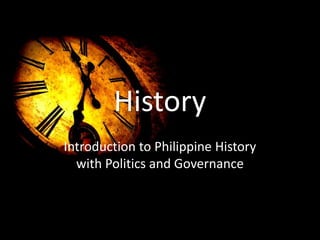
Hist2 0 history-a
- 1. History Introduction to Philippine History with Politics and Governance
- 2. • Records of the past • A record of the human past from the time written records began to appear – Above definitions • Weak • Interviews or oral history and oral traditions, and cultural artifacts are not considered • This notion of “no written records, no history” has confined history to the literate and articulate and has resulted in the production of historiographies from the upper-class male perspectives.
- 3. • Gottschalk (1946) – History is actuality; hence it must study the past as it happened. – This demands that the historian abandon the present. – The practical value of studying and using the past to understand the present is lost. History is studied , written, and taught for its own sake. Traditional Definition
- 4. • History is the reconstruction of the past based on available written records, oral history, cultural artifacts, and folk traditions. • It is the study of events and developments concerning people in the past • It basically involves collection, analysis, and synthesis of limited available materials. • The mere presentation of facts does not constitute history but a chronicle.
- 5. • Historian should do two other important tasks; 1. Interpret and recreate facts in an orderly and intelligible manner; 2. Discover patterns and trends, which govern the behavior of the people and of nations, and to make generalizations out of these. Modern Definition
- 6. • Therefore, history is the interpretative and imaginative study of surviving records of the past, either written or unwritten, in order to determine the meaning and scope of human existence. Modern Definition
- 7. A. Bridging the Gap Between the Past and Present The present is the result of the past The nature and extent of the contemporary problems in the country can be best understood in the light of their historical roots
- 8. B. Explaining Causes of Things and Events No other best discipline can provide explanations for causes of events and/or developments Example: The “state-side mentality” among Filipinos. What was in the past that brought about this mentality?
- 9. C. Projecting the Future Circumstances in the past have been observed to contribute to the unfolding of a significant event. Taking stock of similarities or parallels between the past and the present also leads to consideration of likely possibilities or scenarios in the future
- 10. D. Interpreting Conditions of a Given Space and Time History is the only branch of knowledge that can provide information and corresponding interpretation of periods of history Example: The coming of USA in the Philippines may be explained by going back to the events long before 1898 and finding out what factors contributed to the rise of the US as an imperialist power
- 11. E. Promoting Nationalism and Patriotism History inspires and develops a sense of national pride and sense of devotion to country by recording the exploits and struggles of forefathers to win freedom and independence
- 12. • Written or Inscribe Sources Birth and death certificates Marriage certificatesDirectories Church records Letters and diaries Local newspapers Census reports Title deeds Surveyor’s notes School recordsGovernment recordsBusiness Records Police recordsBooks, journals, and magazinesSouvenir programs Hospital records Inscriptions, Ex. Laguna Copperplate
- 13. • Graphic/Visual Materials and Artifacts PhotographsHeirlooms and keepsakesArts and CraftsTools, weapons, and utensils Old structures and landmarksBuried Artificats Skeletal remains with funerary furniture and paraphernalia
- 15. • Oral History – Letting people tell what they know of certain events or letting them narrate their experiences through the use of a tape recorder – Choice of reliable informants – Requires confirmation of data by other informants
- 16. • Interviews – Use of an interview guide with specific questions – Choice of reliable informants
- 17. THANK YOU!!